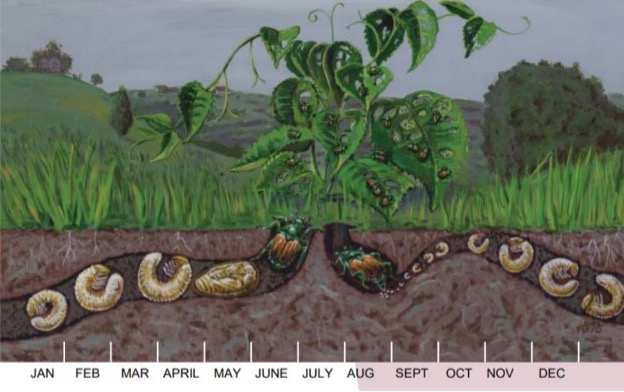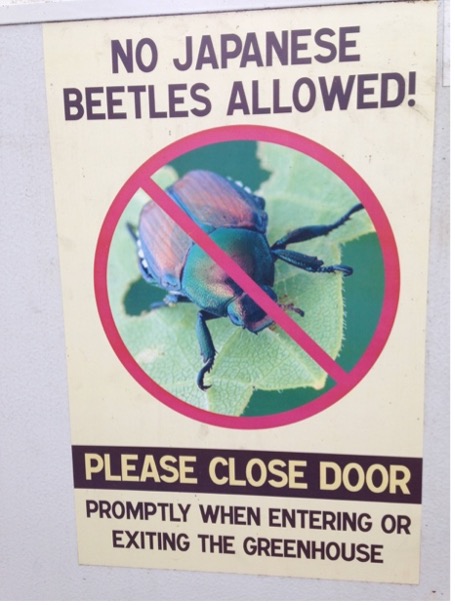Compliance requirements for approved Japanese beetle-free greenhouses and screenhouses
Nurseries and greenhouses must comply with the certification guidelines in the National Japanese Beetle Harmonization Plan to ship plants into western states uninfested with Japanese beetle.

Japanese beetle is a harmful insect pest that feeds on over 300 plant species and damages both turf and ornamental plants. To support the safe movement of nursery stock to states not yet infested with Japanese beetle, the National Japanese Beetle Harmonization Plan (JBHP) provides uniform certification guidelines.
Growers wishing to ship to states defined as Category One or Two in the JBHP and/or comply with other state exterior quarantines can meet these requirements by obtaining certification as a Japanese Beetle-Free Approved Greenhouse/Screenhouse through the Michigan Department of Agriculture and Rural Development (MDARD). This certification ensures plants are grown in a secure environment that excludes Japanese beetle at all life stages.
JBHP Category One states are uninfested and include states that are generally west of the Rocky Mountains (Washington, Oregon, California, Idaho, Utah and Arkansas) and Hawaii (Figure 1). Category Two states are uninfested or only partially infested and include those in the central U.S. (Montana, Colorado, New Mexico, Texas, Oklahoma, South Dakota and North Dakota) and Alaska.
Requirements for the Japanese Beetle-Free Approved Greenhouse/Screenhouse certification
The following guidance outlines the key requirements for compliance with Japanese Beetle-Free Approved Greenhouse/Screenhouse certification.
The most important component of an effective Japanese beetle management program is understanding the life cycle (Figure 2). Educate yourself and your employees about Japanese beetle and its life cycle to improve understanding and meet the goal of Japanese beetle exclusion from your growing facility.

Pre-production requirements
- All growing media must be sterilized, except commercially processed or prepared soilless materials.
- Plants must be bare root before planting into the approved medium, ensuring they are free of soil contamination.
Secure greenhouse/screenhouse setup
- During the adult Japanese beetle flight period (approximately June 1 to Oct. 15 unless communicated to you otherwise by an MDARD official), the greenhouse or screenhouse must be secured so that adult Japanese beetles cannot enter (Photo 1). This includes ensuring any openings are properly screened with mesh sizes of 1/8-inch or smaller. Screens should be intact; pay close attention to vents or repaired areas to prevent entry.
- A negative pressure system alone is insufficient; physical barriers like tightly fitting screens are essential.
- All entries must have stop-gap measures in place to prevent the entry of adult beetles. Some examples include double doors, an enclosed vestibule, or remaining locked throughout the flight period.

Annual inspections and compliance
- An MDARD official must inspect the greenhouse or screenhouse before the adult flight period begins, typically between March and May. This inspection ensures preventive measures are in place and the facility is approved as a secure area.
- The greenhouse must be inspected annually by MDARD officials for prevention of all life stages of Japanese beetle, including larvae and pupae. The inspection will confirm that the space is sealed properly, and all measures, like screens and door security, are intact.
Employee awareness and training
- Employees must be trained to understand the significance of this certification and the importance of maintaining the integrity of the greenhouse's security. This includes understanding that no Japanese beetle-contaminated material is allowed inside the greenhouse at any time.
- Signage (Photo 2) should be posted to alert employees and visitors of the secure status of the facility and the specific requirements that must be upheld.
- Example language for the sign: “This house is screened to comply with Japanese beetle regulations. Please be sure door is kept closed. Report any holes in screens immediately.”

Post-production and shipping
After the adult flight period, plants and their growing medium must be protected from possible infestation while being stored, packed and shipped. Special care should be taken to ensure certified stock is not transported into or through areas infested with Japanese beetles, unless strict safeguards are in place to preserve the identity of the plants and prevent infestation. Refer to the JBHP and contact MDARD if you have any questions.
Certification and phytosanitary documentation
To qualify for certification, the facility must be under a compliance agreement and undergo inspection by MDARD officials before the adult flight season. Once approved, the nursery will receive a certificate with the Additional Declaration: “The rooted plants (or crowns) were produced in an approved Japanese beetle (Popillia japonica) free greenhouse or screenhouse as provided in the U.S. Domestic Japanese Beetle Harmonization Plan.” This must accompany all shipments to Category One or Two states.
Remediation of non-compliance
If deficiencies are found during inspections, such as damaged screens or unapproved materials, they must be addressed before the flight period. A reinspection or photos may be required to confirm repairs have been made.
By meeting this criteria, nurseries can ensure their plants are certified as Japanese beetle-free and comply with the necessary regulations to ship to Category One and Two states, preventing the spread of this invasive pest.
Thank you to Amber Neils, Michigan Department of Agriculture and Rural Development, for consulting and review of this article.



 Print
Print Email
Email

